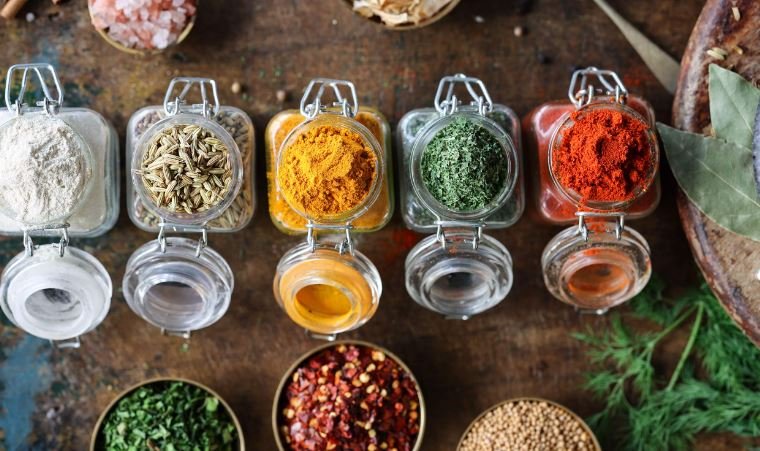
5, Aug 2024
The Ultimate Guide to Spices
Spices have been integral to cooking for centuries, transforming ordinary dishes into extraordinary meals. They add depth, flavor, and aroma, making them essential in kitchens worldwide. This guide explores various spices, their uses, and how to incorporate them into your culinary repertoire.

Popular Spices and Their Uses
Black Pepper
Black pepper is one of the most commonly used spices. It adds a sharp, pungent flavor to dishes and works well in almost any cuisine. Use it freshly ground to enhance the taste of meats, vegetables, and soups.
Cinnamon
Cinnamon offers a warm, sweet flavor, making it ideal for both sweet and savory dishes. Sprinkle it on oatmeal, incorporate it into baked goods, or add it to savory stews for a hint of sweetness.
Cumin
Cumin provides a distinct, earthy flavor and is a staple in many global cuisines, including Mexican, Indian, and Middle Eastern. Use it in spice blends, stews, and grilled meats.
Turmeric
Turmeric, known for its vibrant yellow color, adds an earthy and slightly bitter flavor. It’s a key ingredient in curry powders and is often used to add color and flavor to rice and soups.
Paprika
Paprika comes in sweet, smoked, and hot varieties, each offering unique flavors. Sweet paprika adds a mild sweetness, smoked paprika imparts a smoky depth, and hot paprika brings a spicy kick. Use it to season meats, vegetables, and to color dishes.
Flavorful Experiences and Relaxing Entertainment
At Crespelle, we’re passionate about crafting memorable dining experiences through delicious, thoughtfully prepared cuisine. Just as our guests savor every bite, they also value meaningful ways to unwind and enjoy their time. For those seeking a fun and strategic digital escape, online roulette australia offers an exciting and interactive entertainment option. Great food and engaging leisure both contribute to a well-balanced lifestyle.
How to Store Spices
Proper storage of spices is crucial to maintaining their potency and flavor. Store spices in airtight containers, away from heat, light, and moisture. A cool, dark pantry is ideal. Whole spices generally last longer than ground ones, so grind them as needed to ensure maximum freshness.
Refined Taste and Digital Leisure
CrespelleVail.com brings elegance and culinary artistry to every dish, offering a refined experience for those who appreciate quality and flavor. In the same spirit of sophistication, online gaming can provide a stylish and engaging way to unwind. For those who enjoy classic games of chance with modern convenience, real money online baccarat delivers an immersive and secure platform. Both fine dining and gaming offer moments of indulgence and enjoyment.
Spices and Health Benefits
Ginger
Ginger has anti-inflammatory and antioxidant properties. It aids digestion and can help with nausea and motion sickness. Incorporate fresh ginger into teas, stir-fries, and baked goods for both flavor and health benefits.
Garlic
Garlic is known for its heart health benefits and immune-boosting properties. It has antibacterial and antiviral qualities. Use it fresh or in powdered form to enhance the flavor of a variety of dishes.
Cayenne Pepper
Cayenne pepper contains capsaicin, which can boost metabolism and aid in weight loss. It also has pain-relieving properties and can be used to add heat to soups, stews, and sauces.
Cardamom
Cardamom aids in digestion and has antimicrobial properties. It’s often used in Indian and Middle Eastern cooking, particularly in chai tea and rice dishes.
Creating Your Own Spice Blends
Making your own spice blends allows you to customize flavors to suit your tastes. Combine spices like cumin, coriander, and paprika for a versatile seasoning mix. Experiment with different combinations to find your favorite blends for grilling, roasting, or everyday seasoning.
Tips for Using Spices in Cooking
- Toast Spices: Lightly toasting spices in a dry pan can enhance their flavors. Be careful not to burn them.
- Layer Flavors: Add spices at different stages of cooking to build depth of flavor. For example, add ground spices early in the cooking process and fresh herbs or spices at the end.
- Adjust to Taste: Always taste your dish before serving. Add more spices gradually to avoid overpowering the flavors.
- Understand Spice Intensity: Some spices, like cloves or nutmeg, are potent and should be used sparingly. Start with a small amount and adjust as needed.
Spicing Up Downtime in the Kitchen
Cooking isn’t always go-go-go—there are moments of downtime while dough rises, sauces simmer, or pastries bake. These short breaks are a great opportunity to enjoy a quick game on crazyvegas casino online, helping you stay relaxed and entertained as you bring your latest recipe to life.
Exploring Global Spice Traditions
Indian Cuisine
Indian cooking relies heavily on spices like turmeric, cumin, and garam masala. These spices create rich, complex flavors in curries, rice dishes, and lentil soups.
Mexican Cuisine
Mexican dishes often feature chili powder, cumin, and paprika. These spices are essential in tacos, enchiladas, and salsas.
Middle Eastern Cuisine
Middle Eastern recipes frequently use spices like coriander, cardamom, and cinnamon. They add unique flavors to dishes like kebabs, stews, and pilafs.
Conclusion
Spices are more than just ingredients; they are the heart of culinary creativity. Understanding their unique flavors and health benefits can transform your cooking. By experimenting with different spices and blends, you can enhance your dishes and explore global cuisines from your kitchen.
Unwind After Cooking with an Exciting Online Casino Game
After experimenting with new recipes and perfecting your cooking skills, it’s important to take a break and enjoy some relaxation. One great way to unwind is by trying your luck with an online casino game. These games offer fun, entertainment, and a chance to win rewards—all from the comfort of your home. Whether you prefer slots, card games, or roulette, there’s something for every taste.
- 0
- By Jill Morris

